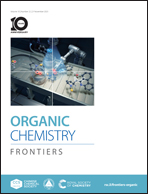Direct and modular access to allylic amines via nickel-catalyzed three-component coupling†
Abstract
The preparation of allylic amines by transition metal catalysis has played an important role in synthetic chemistry; however, the main employment of prefunctionalized coupling partners through multistep synthesis from available starting materials limits the scope and applications of allylic amines. In this context, we develop a Ni-catalyzed three-component coupling of commercially available aldehydes, amines and alkenes. Avoiding the isolation of an imine intermediate, this direct and modular approach delivers a number of versatile allylic amines in high to excellent yields. Diverse aliphatic aldehydes are well tolerated in this reaction, largely reducing imine–enamine tautomerization and self-condensation, hydroamination and hydroacylation of alkenes, and alkenylation of aldehydes, showing high regio-, chemo- and stereoselectivity. The practical applicability of this method is also demonstrated by the late-stage diversification of various natural products and drugs, as well as an array of product transformations. Preliminary asymmetric attempts provide enantio-enriched allylic amines in up to 48% ee by using a chiral phosphoramidite ligand, offering the direction for further optimizations.



 Please wait while we load your content...
Please wait while we load your content...